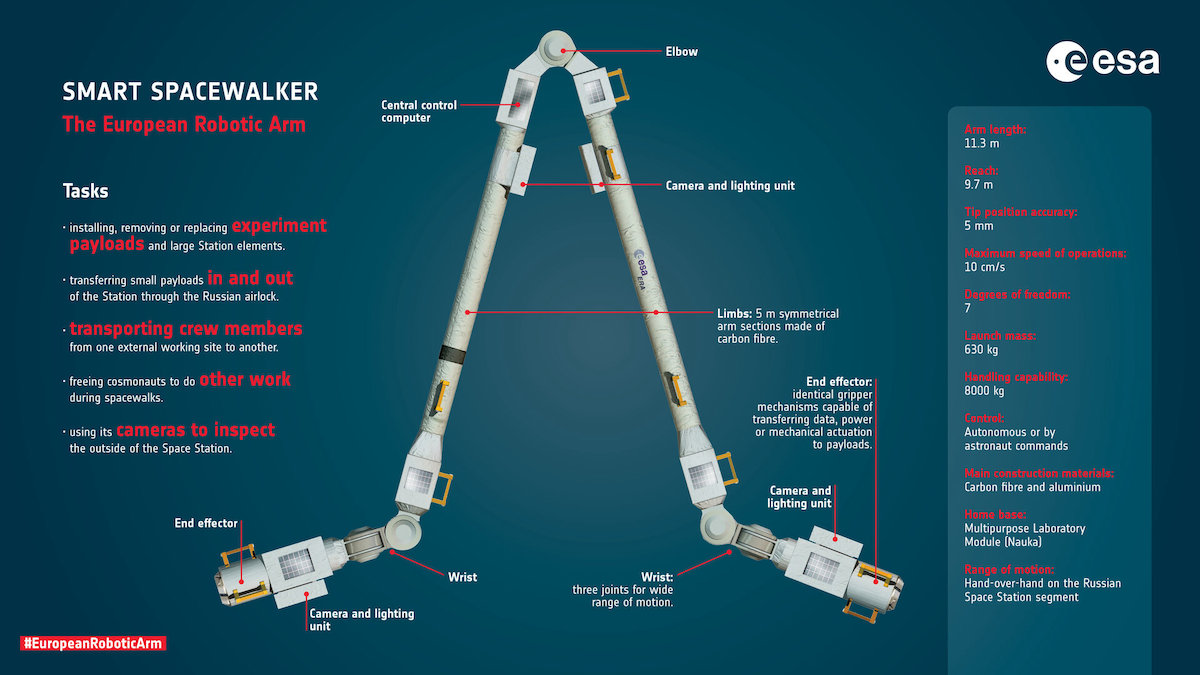30.04.2022

Two Russian cosmonauts unlocked the European Robotic Arm from its launch moorings on a spacewalk Thursday, allowing the manipulator to move around outside the International Space Station for the first time.
Wearing Russian Orlan space suits, the cosmonauts opened the hatch to the Poisk airlock at 10:58 a.m. EDT (1458 GMT), marking the official start of the spacewalk.
Artemyev and Matveev’s previous spacewalk on April 18 began work to activate the European Robotic Arm, a 37-foot-long (11.3-meter) manipulator delivered to the station last July with Russia’s Nauka science module.
The cosmonauts connected a control panel for future crews to command the robotic arm, then removed protective covers from various robot arm components, and installed handrails on the Nauka module.
On Thursday’s spacewalk, the cosmonauts removed thermal blankets from the arm and jettisoned them overboard. The bundle of thermal blankets is expected to soon burn up during re-entry into the atmosphere.
Artemyev and Matveev then released launch locks that firmly held the arm in its folded configuration for the journey to the space station last year. The launch locks were located at the elbow joint and end effectors, or hands, of the European Robotic Arm.
Those tasks freed up the manipulator for movement. Artemyev and Matveev monitored the first commanded movements of the robotic arm, under the control of crewmate Sergey Korsakov inside the space station.
One of the robotic arm’s end effectors moved for the first time shortly after 2 p.m. EDT (1800 GMT).
“It’s a beautiful sight, you know,” one of the cosmonauts said.

The European Robotic Arm is the third system of its kind at the station, joining the Canadian and Japanese robot arms on the U.S. section of the research complex.
Like the Canadian robotic arm, the European arm has the ability to “inchworm” between grapple fixtures, or base points, at multiple locations on the space station. While the Canadian arm is positioned on the U.S. segment of the complex, the European arm has access to the Russian modules.
With the launch locks released, Artemyev and Matveev monitored the arm as it translated one of its end effectors to a second base point Thursday in a “walkoff” maneuver.
“Wow, you can see ERA performing docking,” one of the spacewalkers said.
The cosmonauts working outside the station Thursday also installed more handrails on the robotic arm, and inspected a Kurs rendezvous radar antenna on the Russian Prichal module for a possible obstruction from debris. The Kurs system is used to help navigate Soyuz and Progress crew and cargo ships to the space station.
Artemyev and Matveev also briefly unfurled a flag commemorating Russia’s Victory Day celebrating the defeat of Nazi Germany in World War II.
The spacewalkers ran out of time before the day’s final planned movement of the robotic arm, which would have maneuvered one of the arm’s hands to a third base point — a so-called “double walkoff.”
The cosmonauts returned to the airlock and closed the hatch at 6:40 p.m. EDT (2240 GMT), wrapping up a 7-hour, 52-minute spacewalk.
Full-scale development of the European Robotic Arm began in 1996, and the arm was in storage more than a decade to wait for Russia’s Nauka lab module to be ready for launch. The European arm, primarily built in the Netherlands, was originally planned for launch on a NASA space shuttle.
“ERA is a bit different than the other manipulators that already on the station,” said Philippe Schoonejansm, the European Space Agency’s ERA project manager. “It can be fully preprogrammed in advance, which is helpful. It can be operated from external control panel, which the others do not have. So even when you’re doing a spacewalk, you can control ERA by just seeing and operating this control panel. But also it can operated from inside using only a laptop, so it doesn’t need any joysticks.”
ESA says the arm capable of carrying a load of more than 17,000 pounds, or 8 metric tons, with a precision of one-fifth of an inch (5 millimeters).
The excursion Thursday was the 250th spacewalk since 1998 in support of space station assembly and maintenance.
The spacewalk was the fifth Artemyev’s cosmonaut career, and the second for Matveev. Artemyev, Matveev, and Korsakov arrived at the space station last month on a Soyuz spacecraft.
The next spacewalk to continue activating the European Robotic Arm is scheduled for late May.
Quelle: SN
